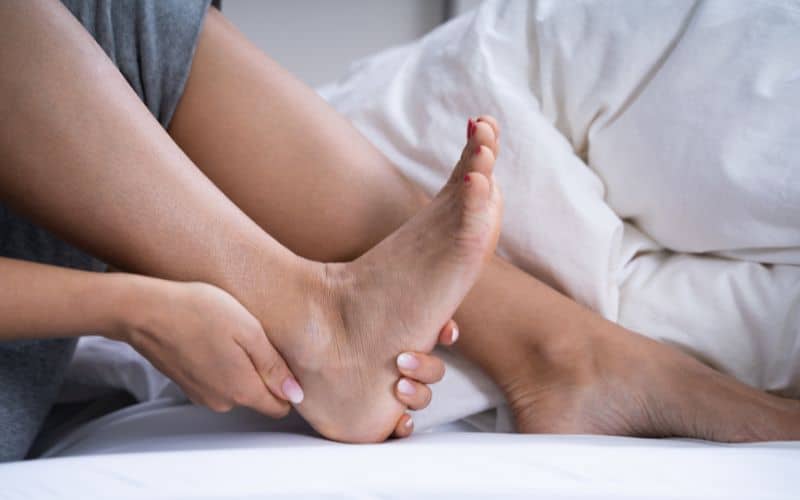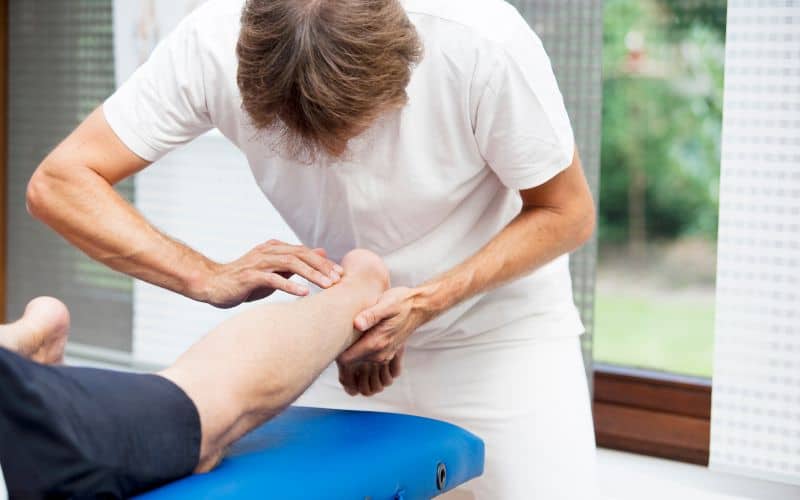Cycling is an activity that allows me to get outside and experience fresh air, or travel across town without the need for a car. Proving to be quite the pandemic-resistant pastime, I’ve enjoyed increasing my cycling over the past few years. However, sometimes I’ve gone a bit overboard. For example, don’t try 10 miles of hills if the bike has been in the garage for the last 3 months!
Cycling can provide a fantastic way to rehabilitate Achilles Tendonitis. Cycling is a lower-impact activity, reducing the strain on your tendons and joints. Cycling can help build up those supporting muscles whilst you recover.
Overuse injuries can happen to anyone from office workers to athletes. It’s pretty common to strain or sprain a muscle as well.
When it comes to cycling, I wanted to know if my efforts made my Achilles tendonitis better or worse. Could I manage this newly revamped hobby to help my recovery? Instead of hurting myself and causing an increase in pain or damage. Most important to me:
- How does cycling impact my body?
- How can I safely cycle for my joints and tendons?
- How can I support Achilles tendonitis recovery?
- How can I avoid further injury?
Here are some of the topics I explored.
How Does Cycling Affect The Body?
Cycling improves overall health. This seems to be a factor across all ages as well. In one 2016 study in the Journal of the American Heart Association, a demographic I personally identify with is middle-aged bicycle commuters.
Basically, across the board, health improved and the risk of disease decreased for those who ditched the car and hopped on a bicycle.
Over a ten-year period, the Swedish commuters studied experienced improved cardiovascular health, decreased diabetes risks, and lower odds of obesity. A repeat of what I already expected to be true, it’s clear that regular cycling is a great tool in the health toolbox.

Yet while that study covered risks of common aging concerns, I wanted to know how it helped my joints.
Once again, most studies seem to agree that overall. Cycling is great for supporting bone and joint health, in a large part because it is a low-impact exercise. In fact, cycling is a recommended activity for those struggling with certain knee difficulties such as patellofemoral osteoarthritis.
The only contradiction for cycling as a regular exercise was gauged towards conditions with severe patella pain. This was in cases where riding a bicycle would otherwise be safe. For a few highly specific conditions such as this, the extreme bend of the knee could prove more painful than helpful.
Diving further, I wondered, were there specific differences between men’s and women’s cycling?
Related article – Is Cycling Good For Tight Hamstrings?
Are There Exercise Differences By Sex?
I wanted to know if my physical build might make me more at-risk for specific injuries or joining problems. There are definitely differences between men’s and women’s cycling routines and performance. This is especially highlighted in elite cyclists.
If you aren’t training for the Tour de France, it’s unlikely these high-level differences between the sexes will have much impact. For example oxygen saturation and the effect of subtle body fat differences on hill climb speed.
If you are cycling for overall health, there has been a recent study that indicates different times of day may favor when to exercise for men and women. Certain times of day have a larger effect on blood pressure, weight loss, and mental health.
If health goals are involved, try cycling in the morning or evening accordingly — or simply commute to work by bike for the best of both worlds. My take on this is just to get your exercise in rather than trying to optimize for the time of day!
Overall though, it seems clear that cycling is a boon to the health of both men and women. At no point did I find any specific guidance on joint or injury by gender at amateur levels.

What Is Tendonitis?
Tendonitis is, simply, an inflammation of the tendon. Tendons are the “thick cords” that attach your muscles to your bones and these cords can get inflamed from overuse or injury.
Tendonitis often begins as a mild ache in the affected area, with pain that can increase after use or exercise. Some people will experience stiffness due to tendonitis. Often, tendonitis can be treated at home without significant medical interventions.
While tendonitis symptoms can include occasional severe pain, extreme and sudden pain is likely to indicate something more severe than inflammation. This could be a torn tendon and should be immediately seen by a medical professional.
Some common repetition injuries have given specific types of tendonitis colloquial names like:
- Tennis elbow
- Golfer’s elbow
- Pitcher’s shoulder
- Swimmer’s shoulder
- Jumper’s knee
Related article – Is Cycling Good For Plantar Fasciitis?
Cycling And Achilles Tendonitis
When it comes to cycling, the most common tendonitis complaint is Achilles tendonitis. This refers to inflammation of the Achilles tendon at the back of the foot and ankle as well as the lower calf.
A common complaint with runners and athletes approaching middle age, the Achilles tendon is vital for pedaling and stability when stationary.
Whether in the lower leg or in a different tendon such as the knee or ankle, tendonitis treatment generally follows the same guidelines.
Related article – When Should I Replace My Bike Pedals?

How Is Achilles Tendonitis Treated?
Treatment for tendonitis usually involves over-the-counter anti-inflammatory first, such as Ibuprofen.
The time-tested injury rehab of R.I.C.E is highly recommended, using rest, ice, compression, and elevation. Some people also benefit from placing a lift in their shoes. This helps to alleviate the strain and stretching at the back of the foot, referred to as an orthotic device.
When home-care measures don’t work or if the tendonitis is regularly recurring, you may be referred to a physical therapist. Physical therapy employs many stretches and strengthening exercises to help rehab that Achilles.
A popular exercise for this specific injury is referred to as “eccentric” strengthening. This involves raising and then very slowly lowering a weight.
It should be noted that an Achilles injury does not prevent overall exercise. Instead, many athletes and casual exercisers alike find that cross-training can help in recovery. It can also help in preventing new repetitive use injuries such as tendonitis. Remember, if in doubt — check with your doctor.
Related article – Best Stretches For Cyclists To Help Recover Faster

How Can Cycling Affect Achilles Tendonitis?
The biggest risk with cycling and Achilles tendonitis is that this inflammation can weaken the tendon. This makes it more prone to later tears or permanent injury.
This means that strenuous exercise or movements that cause significant pain should be avoided. Maybe now isn’t the time to practice those hill climbs, for example.
When compared with running, which is a high-impact exercise, cycling provides a gentle, low-impact solution for slow strength-building.
Take Extra Caution When You’re Injured
Cycling can be a great tool for building up the strength that helps solve and prevent Achilles tendonitis. It can also be done wrong in a manner that causes more harm than good.
One recommendation is to get proper cycling shoes. These shoes are designed to naturally rock on the pedals instead of straining your tendons further.
Consider avoiding uphills, as these inclines will also place more pressure on a sore tendon (as I said, no hill climbs just yet). If you have injuries beyond tendonitis, you may also want to use caution, or perhaps begin on a stationary bike.
Additional injuries may instead aggravate tendonitis while cycling and instead benefit from a custom plan from your physical therapist.
Overall, cycling supports health, including tendon health and tendonitis. Simply cycle wisely and cautiously to build up strength and activity to enjoy this lifelong routine.
Related article – Are Cycling Shoes Worth It?


Had surgery for a fractured Fibula which required a plate and 8 screws back at the end of May. In August my physical therapist gave me the go ahead to start cycling again. I started of gradually and built up to about 10-15 miles daily. In Sept. I racked up 400 miles for the month and was inspired to increase my daily regimen and cranked out 500 miles in October. In November I backed off and went back to 15 miles a day but then seemed to have strained my calf and or Achilles after I had backed off on my daily mileage. Also have some swelling in my foot ( possibly from water retention) My surgeon took x rays and confirmed that the hardware in my fibula is not broken and the bone is completely healed. He did advise me to back off on the 500 miles/ month and work on some stretching exercises at home. I have grown to really appreciate cycling as it has otherwise improved my health and dropped my A1C from an 8 to a 6.4 (which made my primary care physician very happy). I guess my main concern is that I don’t want to cause any serious tendon or muscle damage. My doctor just put me back on diuretics after I told him that it wasn’t the plate in my fibula that was causing the foot swelling. Your article gave me some reassurance. Hope i’m interpreting it correctly. I am currently doing about 10-12 miles every other day.
Sorry to hear about your injury and glad you’re on the mend! I’m not a doctor/PT but I’ve found stretching and strengthening the calf has really helped with Achilles issues. Has the PT given you a cycling program to help manage the issue until you’re pain-free?